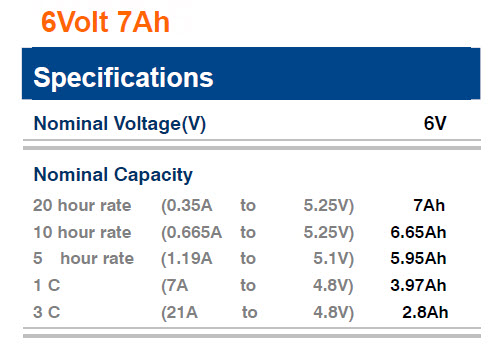PG1995
Active Member
Thank you for pointing this out although I knew that Ah rating is dependent upon the current drawn.
Let's talk about how Ah rating is affected by the current drawn.
Q1:
We will use this datasheet for lead-acid AGM 6V, 7Ah battery:
https://drive.google.com/file/d/0B_XrsbDdR9NEZWRyRzB6bndodUE/view?usp=sharing
i: In the table below, it can be seen that if the current drawn is 0.35A then the battery gives full 7Ah and when closed circuit voltage falls to 5.25V then the battery has fully discharged. Could you please confirm the information underlined?
On the opposite if the current drawn is 7A then it only gives 3.97Ah and the closes circuit voltage indicates the battery has fully discharged.
ii: I had though that "C" in the first column stands for 'capacity' but I don't think that it's correct. It should have something to with time.
7A*1C=3.97Ah
=> C = 34 minutes
Do you agree that "C" stands for 34 minutes

Q2:
Is the table below using voltage for a single lead-acid battery cell which has voltage of around 2.3V because voltages shown in the top row, like 1.85V, 1.8V, 1.75V, etc., are too low for a 6V lead-acid battery which consists of 3 cells?

This curve shows charging profile of a single cell of lead-acid battery.
Please help me with the queries. Thanks.
Regards
PG
UPS run-time calcs:
**broken link removed**
It seems as if you need to consult the manufcturer's data.
You have a non-linear amp-hour capacity depending on discharge rate. See here: https://www.batteryweb.com/pdf/inverter_battery_sizing_faq.pdf
Amp-hours is an estimate only and might not even be close.
Let's talk about how Ah rating is affected by the current drawn.
Q1:
We will use this datasheet for lead-acid AGM 6V, 7Ah battery:
https://drive.google.com/file/d/0B_XrsbDdR9NEZWRyRzB6bndodUE/view?usp=sharing
i: In the table below, it can be seen that if the current drawn is 0.35A then the battery gives full 7Ah and when closed circuit voltage falls to 5.25V then the battery has fully discharged. Could you please confirm the information underlined?
On the opposite if the current drawn is 7A then it only gives 3.97Ah and the closes circuit voltage indicates the battery has fully discharged.
ii: I had though that "C" in the first column stands for 'capacity' but I don't think that it's correct. It should have something to with time.
7A*1C=3.97Ah
=> C = 34 minutes
Do you agree that "C" stands for 34 minutes
Q2:
Is the table below using voltage for a single lead-acid battery cell which has voltage of around 2.3V because voltages shown in the top row, like 1.85V, 1.8V, 1.75V, etc., are too low for a 6V lead-acid battery which consists of 3 cells?
This curve shows charging profile of a single cell of lead-acid battery.
Please help me with the queries. Thanks.
Regards
PG
Attachments
Last edited:





